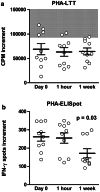DNA lesions correlate with lymphocyte function after selective internal radiotherapy
- PMID: 30877323
- PMCID: PMC11028059
- DOI: 10.1007/s00262-019-02323-x
DNA lesions correlate with lymphocyte function after selective internal radiotherapy
Abstract
In patients with non-resectable hepatic malignancies selective internal radiotherapy (SIRT) with yttrium-90 is an effective therapy. However, previous data indicate that SIRT leads to impaired immune function. The aim of the current study was to determine the extent of DNA lesions in peripheral blood mononuclear cells of SIRT patients and to correlate these lesions with cellular immune responses. In ten patients γH2AX and 53BP1 foci were determined. These foci are markers of DNA double-strand breaks (DSBs) and occur consecutively. In parallel, lymphocyte proliferation was assessed after stimulation with the T cell mitogen phytohemagglutinin. Analyses of vital cells were performed prior to and 1 h and 1 week after SIRT. 1 h and 1 week after SIRT numbers of γH2AX and of 53BP1 foci were more than threefold larger than before (p < 0.01). Already at baseline, foci were more abundant than published in healthy controls. Lymphocyte proliferation at baseline was below the normal range and further decreased after SIRT. Prior to therapy, there was an inverse correlation between lymphocyte proliferation and the quotient 53BP1/γH2AX; which could be considered as a measure of the course of DNA DSB repair (r = - 0.94, p < 0.0001). Proliferative responses were inversely correlated with 53BP1 foci prior to therapy and γH2AX and 53BP1 foci 1 h after therapy (r < - 0.65, p < 0.05). In conclusion, DNA foci in SIRT patients were correlated with impaired in vitro immune function. Unrepaired DNA DSBs or cell cycle arrest due to repair may cause this impairment.
Keywords: Cellular immune response; DNA double strand break; DNA repair; ELISpot; Lymphocyte proliferation; Selective internal radiotherapy.
Conflict of interest statement
The authors declare that they have no conflict of interest.
Figures





References
-
- Dezarn WA, Cessna JT, DeWerd LA, et al. Recommendations of the American Association of Physicists in Medicine on dosimetry, imaging, and quality assurance procedures for 90Y microsphere brachytherapy in the treatment of hepatic malignancies. Med Phys. 2011;38(8):4824–4845. doi: 10.1118/1.3608909. - DOI - PubMed
MeSH terms
Substances
LinkOut - more resources
Full Text Sources
Miscellaneous

